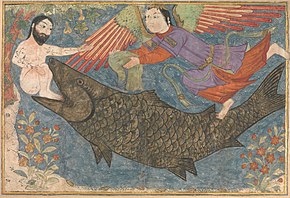Yunus (surah)
According to tafsir chronology (asbāb al-nuzūl), it is believed to have been revealed before the migration of the Islamic prophet Muhammed and his followers from Mecca to Medina (Hijra), as such, it is known as a Meccan surah.
The remaining verses contain the stories of Noah, Moses and Jonah, all considered prophets in Islam.
[2] They also demanded that Muhammad change the Quran to no longer condemn their practice of idolatry and using intercessors when worshipping God.
[2] Based on its context, some verses appeared to date to when Muhammad just started his call to Islam.
[2] According to the fifteenth century commentary Tafsir al-Jalalayn, some said that the surah was revealed sometime after Muhammad's Night Journey (c.
[2] The congruity of the topic unmistakably shows this doesn't contain separated sections or talks that were uncovered at various occasions or on various events.
We have no tradition as to the hour of its disclosure, yet its topic gives a clear sign that it probably been uncovered during the last phase of Muhammad's living at Makkah.
[13] The first ayat 10:1 contains greeting towards the Right Way is reached out to the individuals who were thinking about it a strange thing that Allah's message was being presented on by a person (Muhammad).
The significant issues, divine laws, and instructions in the surah can be listed as follows:- And Allah invites ˹all˺ to the Home of Peace and guides whoever He wills to the Straight Path.
Hamiduddin Farahi, an Islamic scholar of the Indian subcontinent, is known for his work on the concept of nazm, or coherence, in the Quran.

